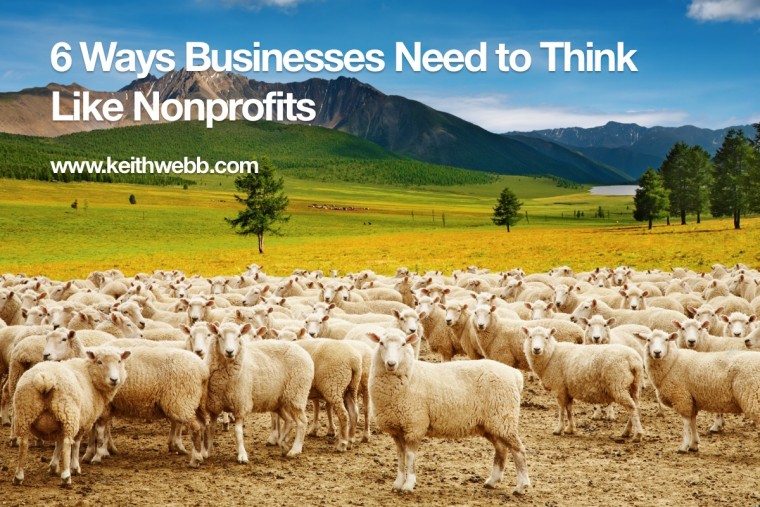For 25 years, I’ve worked with nonprofit organizations. I’ve applied a lot of business principles to nonprofits. These days, I realize that nonprofits have a lot to teach businesses too. Here are 6 ways businesses can learn from nonprofits about purpose, marketing the intangible, and employee engagement.

Nonprofits and businesses are a lot alike and a lot different from each other. The learning comes from using the differences to challenge our practices.
Many don’t know it, but in Peter Drucker’s later years he focused on nonprofits. He wrote, Managing the Nonprofit Organization, the go-to book for all nonprofit leaders. Part of his motivation was due to what he thought nonprofits brought to business management and to the society as a whole.
Here are a few ways that your business can learn from nonprofits that will improve more than just your bottom line.
6 Ways Your Business Needs to Think Like A Nonprofit
- Purpose matters. Your business needs a purpose beyond making money. Shareholder return may motivate your board and executive team, but it does little for your customers and employees. What is the purpose of your business, beyond profit? This purpose will be part of what makes you stand out from other businesses who do something similar. You’ll be more attractive.
- Today, everyone is a volunteer. “One of the great strengths of a non-profit organization is that people don’t work for a living, they work for a cause (not everybody, but a good many),” Drucker wrote, “That also creates a tremendous responsibility for the institution, to keep the flame alive, not to allow work to become just a ‘job’.” Salary is down the list of what employees in businesses really want from their work. They want to be appreciated, learn, feel “in” on things, and know that their work matters in the world. What does your business do to keep work from becoming a ‘job’?
- It’s never “just business,” it’s all personal. In nonprofits, they don’t say, “It’s just serving people, don’t take it personally.” “Serving people” is the point, so of course it’s personal. How you treat your employees matters. The top things employees want from their work all require managers to have and use soft skills on a daily basis. Remember, people don’t quit their companies, they quit their bosses.
- Products and services that change lives, sell. The purpose of a nonprofit organization is to positively change lives. Apple marketed the iPhone and iPad as products that would change your life. They did. They weren’t the most innovative, but perhaps the most integrated for a very large segment of the population. That life change sells.
- Marketing is story telling. Nonprofits market intangible services, which are best marketed by telling stories of changed lives. Businesses too often get caught up listing and praising the features of their products. Instead, tell true stories of how people use your product or service in a life-changing way. Stories provide an emotional connection between the customer’s problem and your product. That is much more effective than any list of features.
- Be more human. Mark Schaefer asked Dr. Robert Cialdini how to stand out in an information-dense world, Cialdini replied, “Be more human.” In business, marketing is often broken into two categories: Business to Business (B2B) and Business to Customer (B2C). Nonprofits have no such distinctions. It’s all People to People (P2P). That’s what is happening in business too. People want to buy from people, not faceless businesses.
Which of these 6 ways of thinking are challenging you right now? Pick one and set specific action steps for how you want to see your business change.
Question: In what ways have you learned from nonprofits? You can leave a comment by clicking here.


Please note: I reserve the right to delete comments that are offensive or off-topic. You own your comments but give me permission to use them. See My Comments Policy. Read my Permissions Policy to know how you can use my posts.